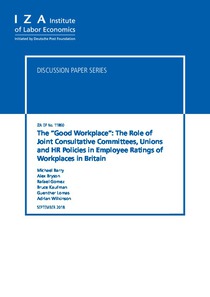The "good workplace": the role of joint consultative committees, unions and HR policies in employee ratings of workplaces in Britain
"Using new, rich data on a representative sample of British workers, we examine the relationship between joint consultation systems at the workplace and employee satisfaction, accounting for possible interactions with union and management-led high-commitment strategies. We focus on non-union em...
| Main Authors: | , , , , , |
|---|---|
| Institution: | ETUI-European Trade Union Institute |
| Format: | TEXT |
| Language: | English |
| Published: |
Bonn
2018
IZA |
| Subjects: | |
| Online Access: | https://www.labourline.org/KENTIKA-19303414124911216969-The-good-workplace-the-role-of.htm |
| Summary: | "Using new, rich data on a representative sample of British workers, we examine the relationship between joint consultation systems at the workplace and employee satisfaction, accounting for possible interactions with union and management-led high-commitment strategies. We focus on non-union employee representation at the workplace, in the form of joint consultative committees (JCCs), and the potential moderating effects of union representation and high-involvement human resource (HIHR) practices. Our findings suggest a re-evaluation of the role that JCCs play in the subjective well-being of workers even after controlling for unions and HIHR policies. There is no evidence in our estimates of negative interaction effects (i.e., that unions or HIHR negatively influence the functioning of JCCs with respect to employee satisfaction) or full mediation (i.e., that unions or HIHR are substitutes for JCCs when it comes to improving self-reported worker well-being). If anything, there is a significant and positive three-way moderating effect when JCCs are interacted with union representation and high-involvement management. This is the first time – to the authors' knowledge – that comprehensive measures of subjective employee well-being have been estimated with respect to the presence of a JCC at the workplace, whilst controlling for workplace institutions that are themselves designed to involve and communicate with workers." |
|---|---|
| Physical Description: | 46 p. Digital |

